Beefsteak Tomatoes Profile
Written by Iris
Feb 07 2023
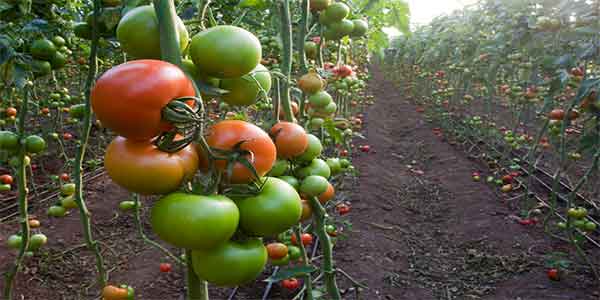
Beefsteak Tomatoes are easy and fun to grow in your home garden. Beefsteak Tomatoes can grow to a pound or more. Whether you slice Steak tomatoes up for a sandwich, cut them into small pieces for a quick pico de Gallo, or eat them straight from the vine, you can't go wrong with Beefsteak Tomatoes. Here's what to know about meaty Beefsteak Tomato: what it is, how to use it, and how to grow and care for a Beefsteak Tomato plant with plenty of juicy tomatoes.

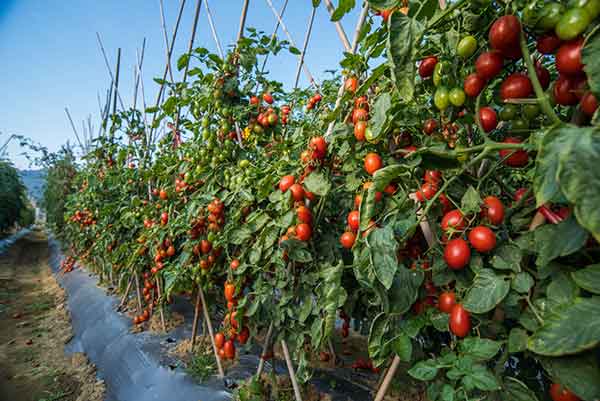
Start by germinating seeds indoors to protect the delicate seedlings from the cold.
The rule of thumb is to plant your tomatoes outside about two weeks after the last frost of the season, once soil temperatures are around 60°F.
You can begin germinating your seeds in flats or small parts. There are many ideal substrates you can use, such as seed starting soil, potting soil, or peat pellets.
Place two beefsteak tomato seeds in each container.
You'll want to plant them about three times as deep as the size of the seed. In most cases, this is about ¼ – ½” deep.
Place in an area with sunlight.
Water when the soil is dry.
Let the seedlings reach about eight inches tall before hardening them off.
Planting outdoors.
Your seedlings will germinate well if you keep them in a warm place that receives plenty of sunlight. After 7 – 14 days, your seeds will germinate and begin to grow.
They'll also need to be hardened off before planting outside. Keep them outdoors for a week with some protection from hot sun and extreme temperatures.
After you've acclimated them to the outdoors for a week, you can plant them. Transplant seedlings into garden bed or right in the ground provided you have nutrient-rich soil.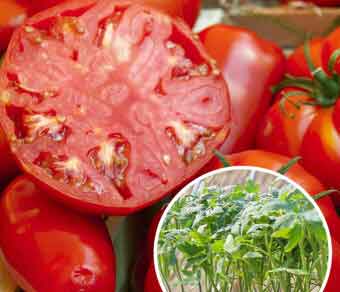
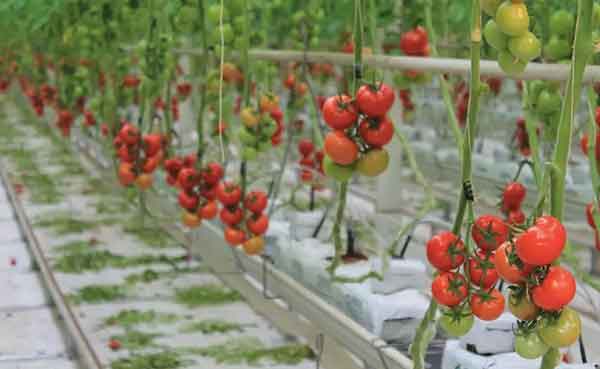
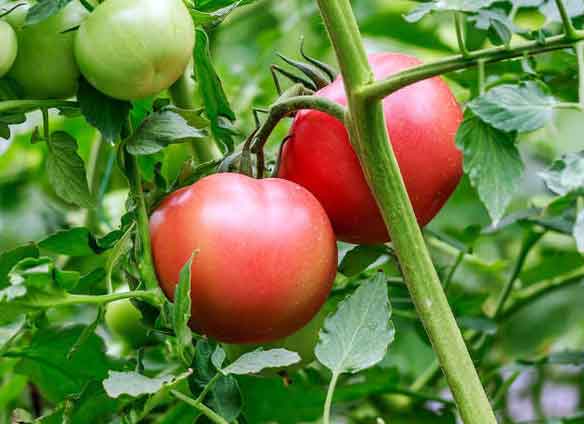
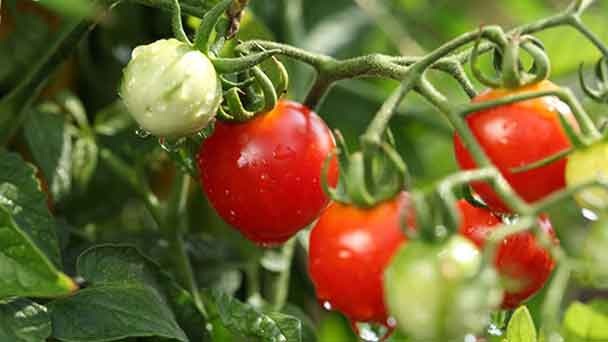
Beefsteak Tomatoes PictureBeefsteak Tomatoes InfoBeefsteak Tomatoes DistributionHow to Grow and Care for Beefsteak TomatoesHow to Grow Beefsteak TomatoesHow to Care for Beefsteak TomatoesUses of Beefsteak TomatoesVarieties of Beefsteak TomatoesBeefsteak Tomatoes Common Pests/DiseasesBlossom end rotTomato blightTomato leaf mouldTomato splitting and crackingBeefsteak Tomatoes Companion Plants
Beefsteak Tomatoes Picture

Beefsteak Tomatoes Info
| Botanical Name | Solanum lycopersicum "Beefsteak" |
| Common Name | Beefsteak Tomatoes |
| Plant Type | Annual, vegetable |
| Mature Size | 6 feet tall or more |
| Sun Exposure | Full sun |
| Soil Type | Fertile, well-drained |
| Soil pH | Slightly acidic |
| Bloom Time | Summer |
Beefsteak Tomatoes Distribution
The beefsteak tomato is by far the most popular type of home garden tomato plant grown in North America. These tomatoes grow fairly easily and quickly, and produce huge (up to 2 pounds) fruits. They aren't often available in the grocery store as they are not well-suited to mechanized growing on a large scale.
How to Grow and Care for Beefsteak Tomatoes
How to Grow Beefsteak Tomatoes
These tomatoes have a long growing season. In most parts of the country, the weather isn’t cooperative enough to grow your plants entirely outdoors.Start by germinating seeds indoors to protect the delicate seedlings from the cold.
The rule of thumb is to plant your tomatoes outside about two weeks after the last frost of the season, once soil temperatures are around 60°F.
You can begin germinating your seeds in flats or small parts. There are many ideal substrates you can use, such as seed starting soil, potting soil, or peat pellets.
Place two beefsteak tomato seeds in each container.
You'll want to plant them about three times as deep as the size of the seed. In most cases, this is about ¼ – ½” deep.
Place in an area with sunlight.
Water when the soil is dry.
Let the seedlings reach about eight inches tall before hardening them off.
Planting outdoors.
Your seedlings will germinate well if you keep them in a warm place that receives plenty of sunlight. After 7 – 14 days, your seeds will germinate and begin to grow.
They'll also need to be hardened off before planting outside. Keep them outdoors for a week with some protection from hot sun and extreme temperatures.
After you've acclimated them to the outdoors for a week, you can plant them. Transplant seedlings into garden bed or right in the ground provided you have nutrient-rich soil.

How to Care for Beefsteak Tomatoes
- Light
- Soil
- Water
- Temperature and Humidity
- Fertilizer
- Pruning

Uses of Beefsteak Tomatoes
There are lots of things to do with beefsteak tomatoes. These thick and fleshy tomatoes are ideal for slicing for sandwiches or burgers, and this use is where they derive their namesake. Still, they are far more than a sandwich topping. They're also an ideal variety for tomato salad, Caprese salad with leaves from your own basil plant, and any other salads. Their mild taste also makes them a great base for sauces and dips. They are flavorful and not acidic.Varieties of Beefsteak Tomatoes
Beefsteak varieties produce fruits in many colors, including red/burgundy, gold/yellow, green, orange, pink, purple/lavender, and variegated. 'Beefmaster,' 'Big Beef,' and 'Big Boy' are among the most popular and easy to find varieties that have adapted to southern heat. 'Mortgage Lifter' and 'Grosse Lisse' are good choices for very humid areas. if you enjoy heirloom varieties, try 'Red Brandywine', 'Pruden's Purple Tomato', also known as 'Prudence', or 'Chocolate Stripes'.
Beefsteak Tomatoes Common Pests/Diseases
Blossom end rot
Dark blotches appear on the ends. Water regularly and not sporadically and never allow the soil to dry out.Tomato blight
Disease that causes fruit and foliage rot, most common in wet weather. Select resistant cultivars.Tomato leaf mould
Leaf mould can develop rapidly to cause significant yield loss in greenhouse-grown tomatoes. It is rarely seen on outdoor crops. Yellow blotches develop on the upper leaf surface. A pale, greyish-brown mould growth is found on the corresponding lower surface. Where the disease is severe the mould growth may also be found on the upper surface. Select resistant cultivars. Provide ample ventilation to indoor Beefsteak tomato crops.- Read More: Why Are My Tomato Leaves Turning Yellow
Tomato splitting and cracking
Cracking or splitting usually does not affect the taste of the Beefsteak tomato, but split fruit left on the plant will often be infected by a fungus, such as grey mould and can cause a variety of physiological disorders. Control temperature and sunlight levels carefully. Feed regularly to maintain high soil fertility. Water to maintain a constant level of soil moisture.
Beefsteak Tomatoes Companion Plants
Beefsteak Tomatoes Companion planting is the process of growing beneficial plants alongside each other for healthier, happier plants and heavier yields. Carrots, onions, garlic, chives, and asparagus are all good Beefsteak tomato companion plants. Avoid planting tomatoes near brassicas like cabbage, kale, or Brussels sprouts. This combination can slow or stunt growth. Tomatoes also struggle near corn, fennel, and potatoes. The beefsteak tomato is prone to the same diseases as other varieties. As this tomato needs more time to grow and ripen, it sits on the vine for longer. This means that it's more exposed to potential pests and diseases. As long as you keep your plants health,y they should be fine.Latest Updated
- Beefsteak Tomatoes Grow & Care Guide
- Beefsteak Tomatoes Profile
- Why Are My Orchid Leaves Turning Yellow - Common Causes & Fixs
- Hong Kong Orchid Tree Problems: Diseases And Remedies
- Hong Kong Orchid Tree Pros And Cons - How Fast Does It Grow
- Why Is My Orchid Stem Turning Yellow - How to Treat
- How to Grow and Care for Cymbidium Orchid (Boat Orchids)
- Why Do My Hibiscus Leaves Turn Yellow - Should I Cut Off Them
- Why Are My Tomato Leaves Turning Yellow - 7 Reasons & Solutions
- 12 Amazing Peace Lily Benefits to Keep Your Garden Fresh!
Popular Articles
- Winter maintenance of Antirrhinum Majus
- How to Grow Terminalia Mantaly Tree
- How to Grow and Care for Crossostephium Chinense
- How to grow Antirrhinum Majus in spring
- Peristeria Elata (Dove Orchid) Profile: Info & Care Guide
- Underwatered Snake Plant (Sansevieria Trifasciata) - Signs And How To Fix
- How to Care for Brazilian Jasmine Plant (Mandevilla Sanderi)
- Rosa Chinensis (China Rose): Plant Growing & Care Tips
- How to Grow & Care for Graptopetalum Purple Delight in Summer
- How to Care for Baby Sun Rose (Aptenia Cordifolia)